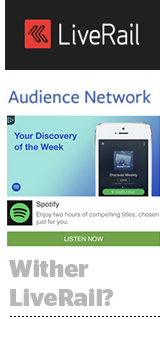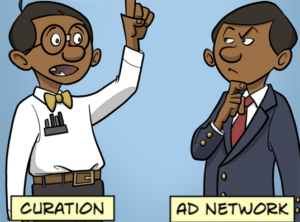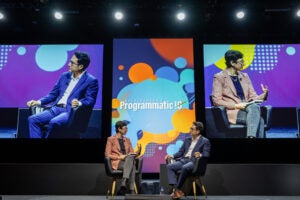 LiveRail, once a dominant video supply side platform and ad server focused solely on publishers, is now a shell of its former self.
LiveRail, once a dominant video supply side platform and ad server focused solely on publishers, is now a shell of its former self.
It’s been nearly two years since Facebook bought the company for $400 million-plus, and in the last six to nine months it has shut down major pieces of it and transferred some employees to other projects.
Now Facebook is preparing to eliminate at least 40 more positions at LiveRail. The roles consist mostly of account managers and sales reps.
Business Insider was first to report news of the reduction, also noting LiveRail’s former CEO Mark Trefgarne exited the company Friday. Trefgarne had lately assumed a position as director of product management for Facebook’s ad-tech group.
Sources close to the company confirmed the layoffs to AdExchanger, noting Facebook had experienced “overlap” between certain Facebook and LiveRail sales positions, which precipitated the layoffs.
Winding Down
Facebook’s first major reduction in the LiveRail business was to remove third-party intermediaries (mainly resellers and video networks) last October.
That stripped out about 75% of the inventory from LiveRail’s ecosystem. (AdExchanger coverage)
Facebook says those were mostly low quality and fraudulent impressions, and that its goal was to shore up premium inventory for advertisers.
Then Facebook sunsetted LiveRail’s video ad server, leaving competitors like Google’s DoubleClick and AppNexus to pounce on publisher customers that were suddenly up for grabs.
“We acquired LiveRail predominantly because we wanted to have a better idea of the video advertising space,” Facebook’s head of advertiser sales and operations Erik Johnson, said recently at AdExchanger’s PROGRAMMATIC I/O conference in San Francisco.
“That’s important for Facebook as a publisher because we have a lot of video inventory, but perhaps more importantly, for some of us on the ad tech side of the house,” Johnson added. “Video ads are some of the strongest performing ads out there and we didn’t know a lot about them. One of the things that was a big surprise to us was the amount of really poor quality, in some cases fraudulent, inventory flowing through the ecosystem.”
What about private deals? Sources with knowledge of Facebook say the company still sees value in LiveRail’s existing private marketplace (PMP) business, and is still driving new client adoption there. The company has existing PMP deals with publishers such as Hulu and A&E.
They say it saw less value in open exchanges, the crux of LiveRail’s business, and instead refocused on direct relationships with publishers.
Other sources suggest LiveRail’s video ad server customers were left in the dark throughout the process. Some cited a lack of notice that products such as the ad server would be phased out.
Given that Facebook has eliminated most parts of LiveRail’s business, some predict the PMP business will suffer the same fate – despite its claims.
“The beauty of LiveRail was that they had an ad server and an SSP integrated. It was unique. And it’s where we think the market is going. And then they decided to shut it down,” said Sorosh Tavakoli, SVP of ad tech at publisher video ad stack Ooyala, which competes with LiveRail. “We’re not sure what happens to the PMP business. Maybe it was someone’s idea to ‘Make PMPs empowered by our data,’ and now they’re just keeping it alive.”
Some had expected Facebook to compete with Google’s DoubleClick stack via LiveRail, which seems less likely to happen now.
“With these LiveRail layoffs it’ll be interesting to hear what Facebook’s future commitment is to help publishers monetize their video with an independent video SSP stack,” added Frank Sinton, CEO of video platform Beachfront.
Facebook sees Audience Network, its mobile ad network business, as its main publisher offering now. Audience Network acts as an extension to ads sold on Facebook, allowing marketers to buy ads laden with Facebook data, across other publisher sites as well.
“There will be a set of solutions for those publishers who plug into Audience Network as well,” Johnson said during the Programmatic.io appearance. He said the ad network platform is “performing well … [and] will be our solution in terms of how we work with publishers.”












